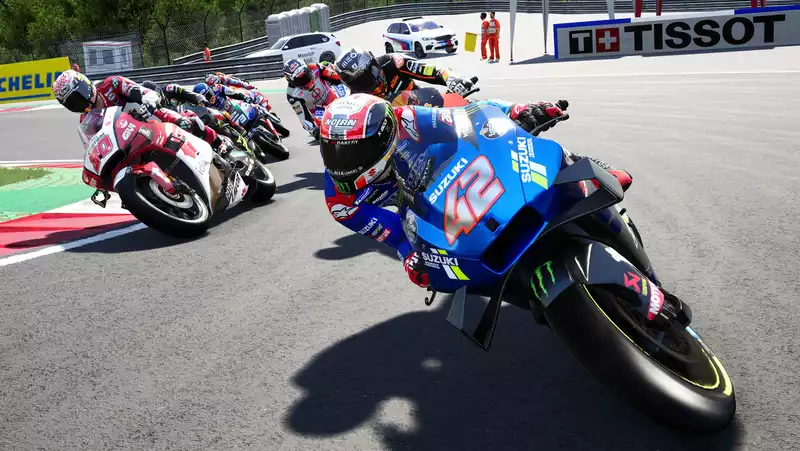Modern MotoGP is in its golden age, with eight different riders winning 18 races in 2021 and three different riders taking the top checkered flag in four races this season. It is unpredictable, full of talent and spectacle, and guarantees entertainment at every race. Naturally, the focus of Milestone's licensed motorcycle simulator MotoGP 22 is the 2009 season.
"Nine: Season 2009" recreates a bygone era when Rossi, Lorenzo, Stoner, and Pedrosa battled for victory on 1000cc machines in a series of documentary-style videos directed and narrated by British filmmaker Mark Neil, and intertwined with a series of challenges. To put it succinctly, it's brilliant.
Neal's narrative and choice of images convey the full background and drama of the time. It doesn't hurt that the challenges are so simple, as the goal of the challenge is always focused on overtaking or gapping the opposition: find the gap between Rossi's knee and the apex, with the classic inline-4 yelp of the full grid of 2009 riders That's it. Frankly, for anyone even remotely interested in the sport, that's enough.
That does not mean that Milestone is shirking its responsibility to simulate this season. As in the past, all three categories of races have been recreated in the 2022 livery. And, as ever, it gives career mode a depth that even Codies' F1 game can't match: start as a Moto3 rookie, sailing the waters of Spain's prodigal teenagers on a light and forgiving 250cc bike; get picked by a Moto2 team and ride with Lowe's, Acosta and Canet, he brushes leathers with them and realizes the weight and power of a bigger bike. Finally, you are promoted to the highest class, and you feel as if you have earned it, as if you have a story to tell to get to this point. Even with the addition of the playable docs for the 2009 season this year, it remains the series' biggest draw.
Mastering the bike, on the other hand, is a bit easier. Last year's title strayed so far into hardcore sim territory that months after its launch I was still routinely out-braking, front-end tipping, and squirming around in the braking zones like an inflatable man in a car dealership storefront. I was not alone. The act of pulling the front and rear brakes independently while managing the rider's weight and leaning slowly enough to reach the apex seemed to require more finesse than two human hands and a controller would allow. Milestone addressed the difficulty of braking this year, but not in a particularly satisfactory manner.
Essentially, the level of assistance has only increased. Before, it was either accept defeat and turn on combined braking and get away with it, or memorize and endure an impossibly clever series of inputs. Now, with the option to modulate the inputs, the result is more forgiving handling at the expense of control. With modulation turned on, you can no longer lean so recklessly that the rear tires start to wriggle, reminiscent of the assist-intensive driving of the Assetto Corsa and Project CARS series. It is certainly easier, but there is no longer a sense of truly controlling the vehicle.
New assists notwithstanding, it still feels very difficult to control the bike on the track. The illusion of an accurate simulation is somewhat shattered when you see the insane buckaroo driving that occurs in the aftermath of a bumpy apex ride. But it's a wonderful feeling to get to the point where you can lean the bike just right, increase your corner speed, and glide past your opponents. At that moment, all is forgiven. Even those moments when the rider is so intent on gesturing at someone else, independent of your input, that you miss the apex.
But what is hard to turn a blind eye to is a long-standing complaint that really should have been fixed by now. The ideal line assist often gets the recommended braking points completely wrong, so when a beginner uses the assist to learn the course, he may be confused to find himself in a gravel trap even though he braked as the game instructed.
The AI remains somewhat unstable. In my experience, the AI is more aggressive this year and is able to determine when it is okay to break inside you mid-corner without causing a collision. However, its pace varies greatly from track to track, and while it seems to struggle with the high-speed sections of Jerez and Assen, it is taking on Austin like a grid full of Marc Marquez.
The developers seem to have squeezed more beauty out of the Unreal Engine this time around, especially in the bikes and helmets. I'm not ashamed to admit that I spent quite a bit of time on the showroom menu, idly cycling between modern and classic riders and admiring their lids. In particular, the glitter paint job on Nicky Hayden's 2006 helmet is worth a few camera rolls. The combination of realistic lighting styles, high-resolution textures, and high-poly models is worthy of Photo Mode's praise.
This new MotoGP title is making inroads. The controls and physics models are not yet perfectly synchronized, and the AI and assists need a bit more work. However, Mark Neil has done a great job of enhancing the experience, creating new modes that make one wonder if more modes like this could be created. How about a mode that recreates the first victory of the winner of the last 10 races? I would love to ride Binder's KTM around the Red Bull Ring or Bagnaia's Ducati and dodge Marquez at Aragon.
.

Comments